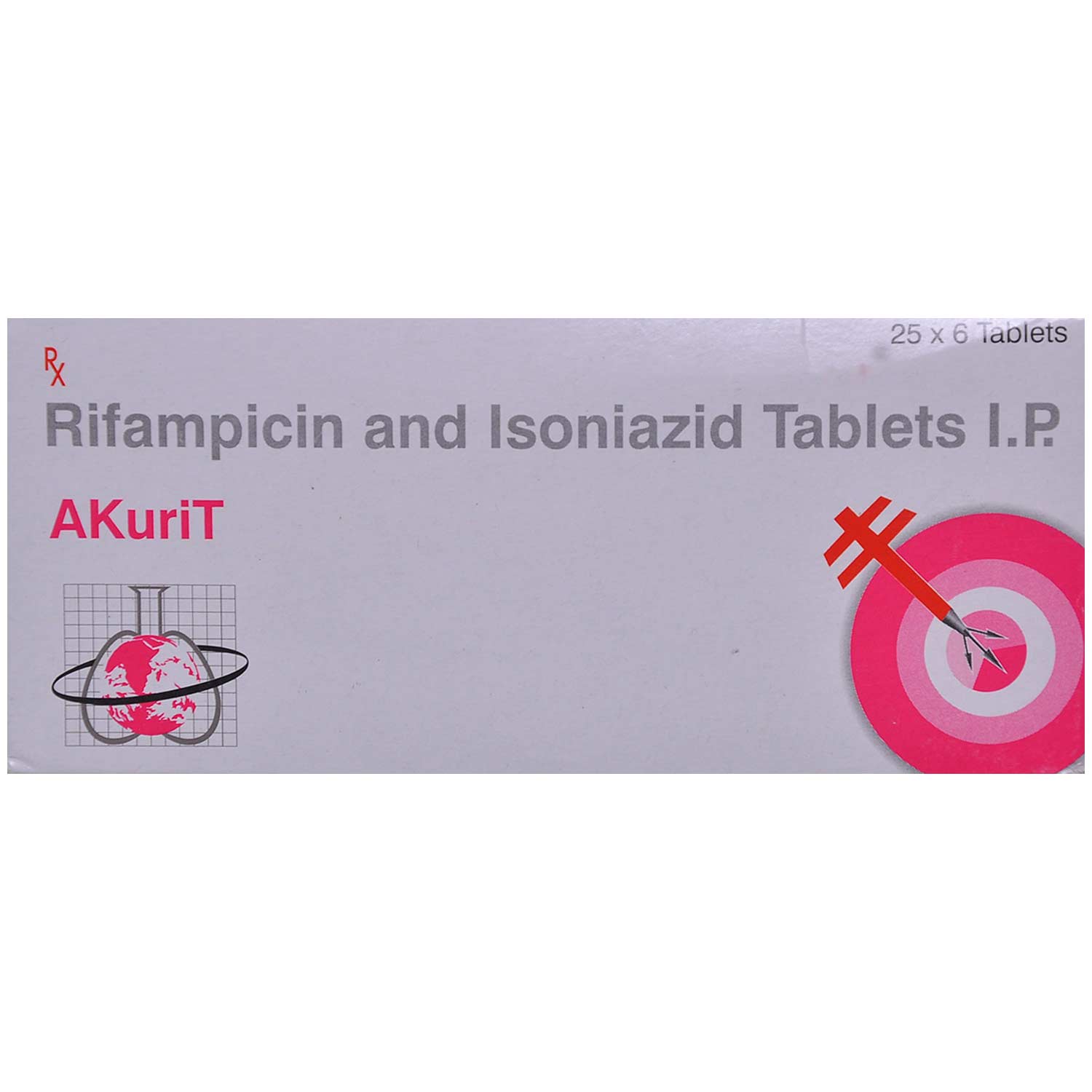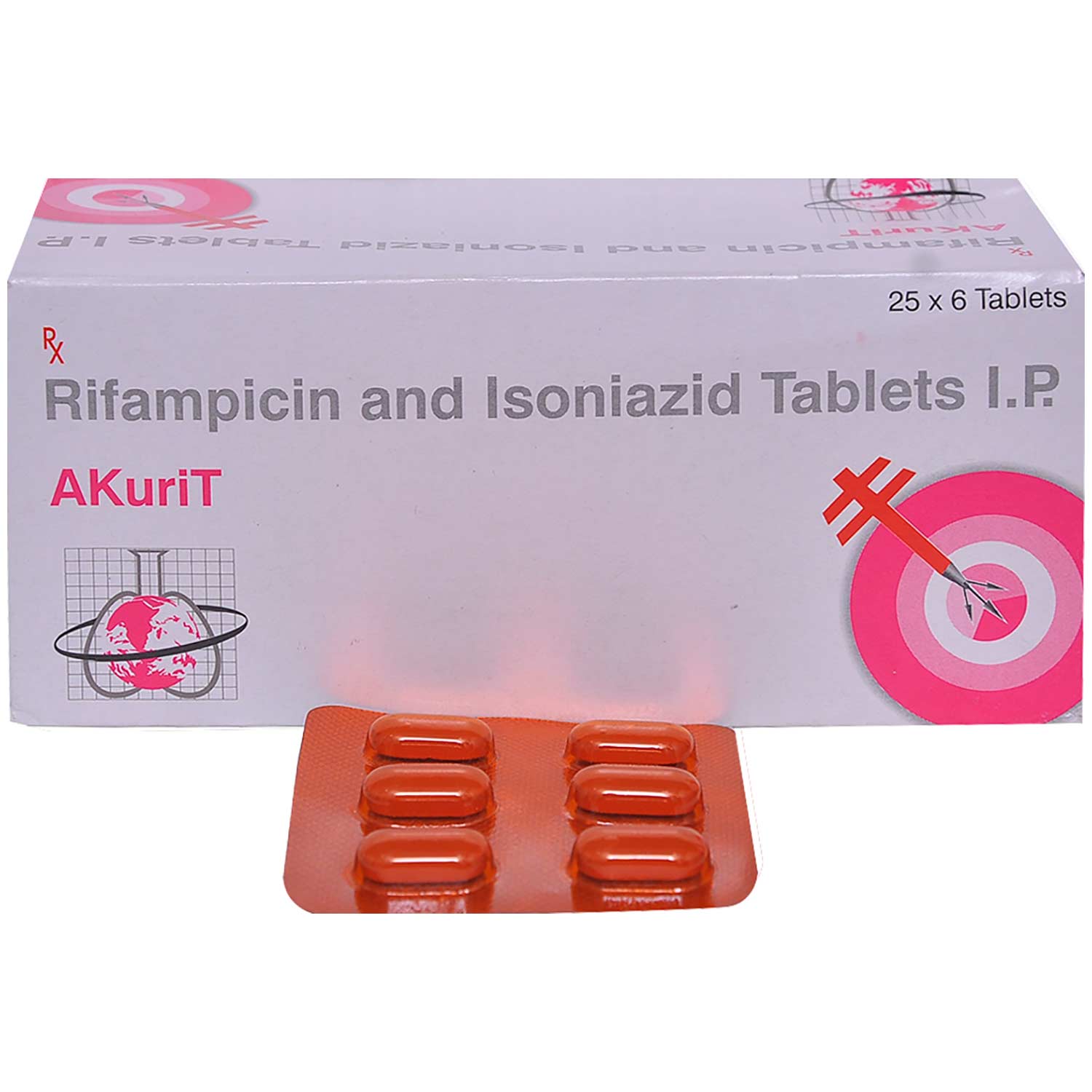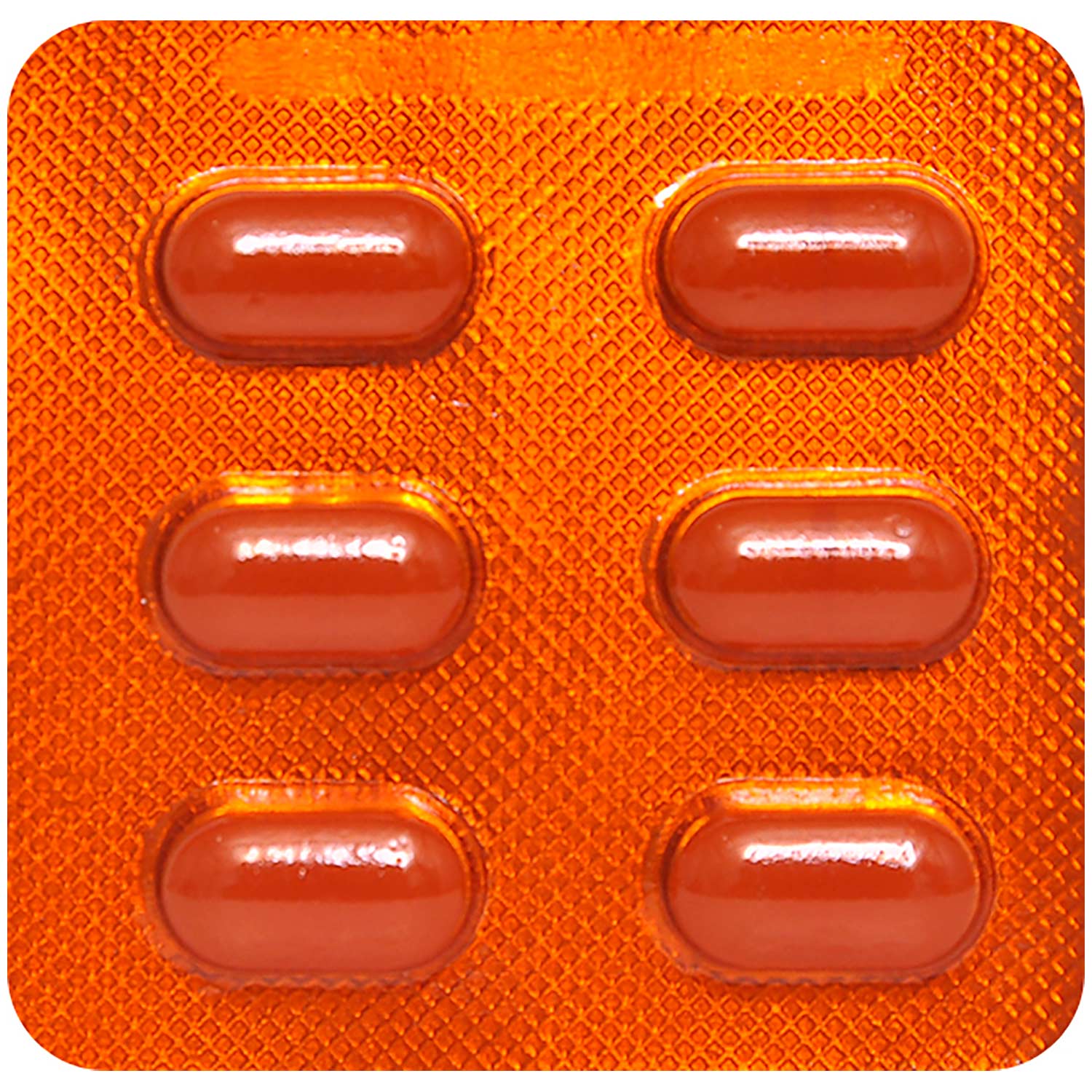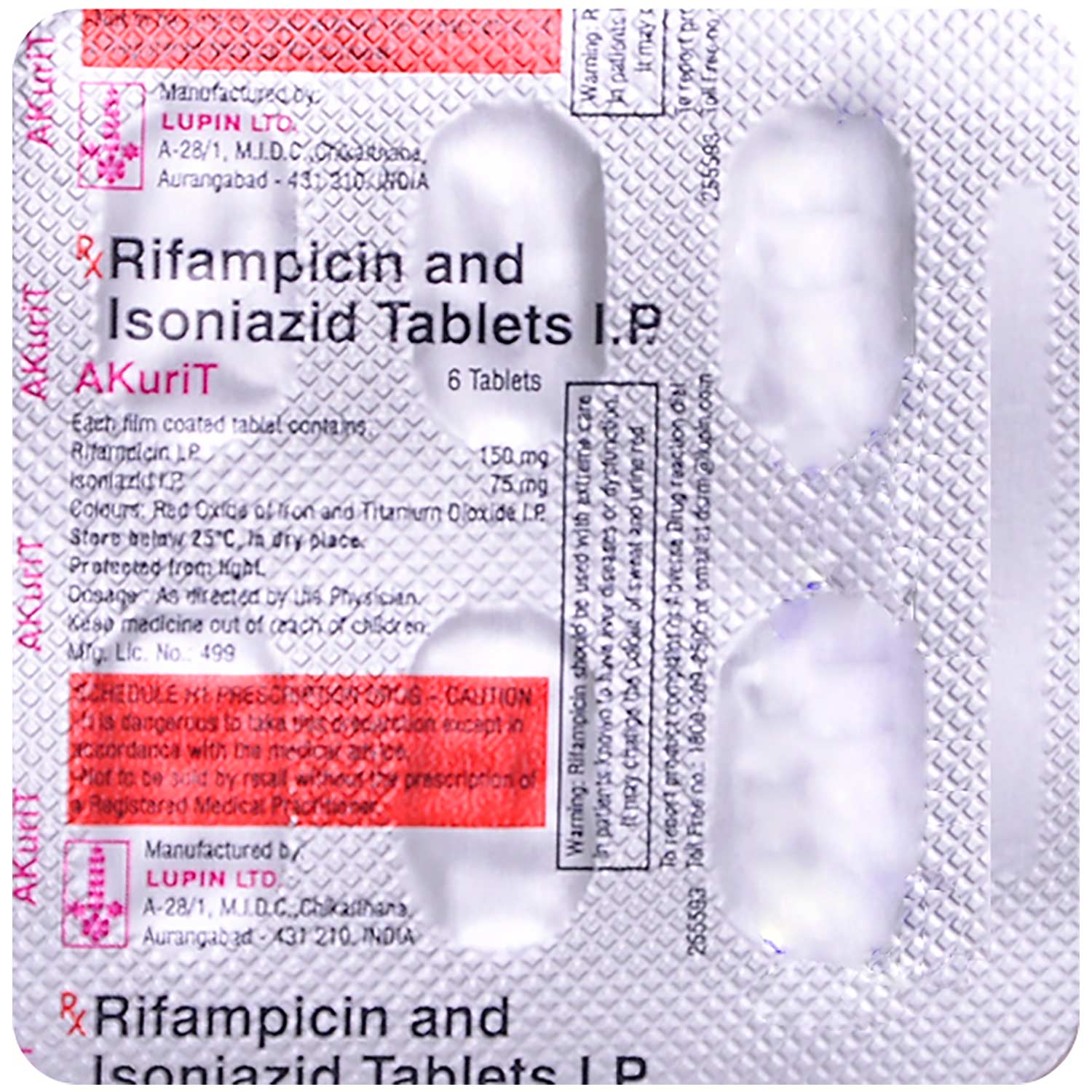Akurit Tablet 6's










MRP ₹22.5
(Inclusive of all Taxes)
₹3.4 Cashback (15%)
Provide Delivery Location
Online payment accepted
 Prescription drug
Prescription drugWhats That
Composition :
Manufacturer/Marketer :
Consume Type :
Return Policy :
Expires on or after :
About Akurit Tablet
Akurit Tablet belongs to the group of medicines called anti-tuberculosis drugs primarily used to treat tuberculosis. Tuberculosis is an infectious disease that mainly affects the lungs, but it can also spread to other body parts such as the kidneys, brain, spine, and bone marrow.
Akurit Tablet contains Rifampicin, and Isoniazid. Rifampicin inhibits DNA-dependent RNA polymerase activity in the bacteria. Isoniazid inhibits the biosynthesis of mycolic acid, which is the major component of the cell wall. Together, Akurit Tablet kills Mycobacterium tuberculosis which causes TB (tuberculosis).
In some cases, Akurit Tablet may cause side effects such as nausea, vomiting, diarrhoea, stomach pain, and loss of appetite. Most of these side effects do not require medical attention and will resolve gradually over time. However, you are advised to talk to the doctor if the side effects persist or worsen.
Let your doctor know if your child is allergic to any of the components in Akurit Tablet. Keep your doctor informed about your child's health condition and medications to rule out any side effects/interactions.
Uses of Akurit Tablet
Directions for Use
Medicinal Benefits
Akurit Tablet belongs to the group of medicines called anti-tuberculosis drugs primarily used to treat and prevent tuberculosis. Akurit Tablet contains two anti-mycobacterial agents, Rifampicin and Isoniazid. Rifampicin inhibits DNA-dependent RNA polymerase activity in the bacteria. Isoniazid inhibits the biosynthesis of mycolic acid, which is the major component of the cell wall. Together, Akurit Tablet kills Mycobacterium tuberculosis which causes TB (tuberculosis).
- If you have excess nerve pain and numbness, soak in Epsom salt and warm water. This can help ease the pain and associated discomfort.
- Use compression socks and make sure to rest for a while to get relief from pain.
- Avoid smoking and intake of alcohol or fluids that aggravate the pain.
- Massage your feet or affected area often to get relief from pain. Take the medication prescribed by your doctor without fail.
- Consult your doctor if you experience skin redness, itching, or irritation after taking medication.
- Your doctor may adjust your treatment plan by changing your medication or providing guidance on managing your erythema symptoms.
- Your doctor may recommend or prescribe certain medications to help alleviate symptoms.
- Apply cool compresses or calamine lotion to the affected skin area to reduce redness and itching.
- Stay hydrated by drinking plenty of water to help alleviate symptoms and keep your skin hydrated.
- Monitor your skin condition closely and promptly report any changes, worsening symptoms, or concerns to your healthcare provider.
- Inform Your Doctor: Notify your doctor immediately about your diarrhoea symptoms. This allows them to adjust your medication or provide guidance on managing side effects.
- Stay Hydrated: Drink plenty of fluids to replace lost water and electrolytes. Choose water, clear broth, and electrolyte-rich drinks. Avoid carbonated or caffeinated beverages to effectively rehydrate your body.
- Follow a Bland Diet: Eat easy-to-digest foods to help firm up your stool and settle your stomach. Try incorporating bananas, rice, applesauce, toast, plain crackers, and boiled vegetables into your diet.
- Avoid Trigger Foods: Steer clear of foods that can worsen diarrhoea, such as spicy, fatty, or greasy foods, high-fibre foods, and dairy products (especially if you're lactose intolerant).
- Practice Good Hygiene: Maintain good hygiene to prevent the spread of infection. To stay healthy, wash your hands frequently, clean and disinfect surfaces regularly, and avoid exchanging personal belongings with others.
- Take Anti-Diarrheal Medications: If your doctor advises, anti-diarrheal medications such as loperamide might help manage diarrhoea symptoms. Always follow your doctor's directions.
- Keep track of your diarrhoea symptoms. If they don't get better or worse or are accompanied by severe stomach pain, blood, or dehydration signs (like extreme thirst or dark urine), seek medical help.
- Drink water or other clear fluids.
- To prevent worsening of pain, limit intake of tea, coffee, or alcohol.
- Include bland foods like rice, toast, crackers, and rice in your diet.
- Avoid lying down immediately after eating as it may cause indigestion or heartburn.
- Avoid acidic and spicy food as it may cause indigestion.
- Inform your doctor about the nausea and discuss possible alternatives to the medication or adjustments to the dosage.
- Divide your daily food intake into smaller, more frequent meals to reduce nausea.
- Opt for bland, easily digestible foods like crackers, toast, plain rice, bananas, and applesauce.
- Avoid certain foods that can trigger nausea, such as fatty, greasy, spicy, and smelly foods.
- Drink plenty of fluids, such as water, clear broth, or electrolyte-rich beverages like coconut water or sports drinks.
- Use ginger (tea, ale, or candies) to help relieve nausea.
- Get adequate rest and also avoid strenuous activities that can worsen nausea.
- Talk to your doctor about taking anti-nausea medication if your nausea is severe.
- Record when your nausea occurs, what triggers it, and what provides relief to help you identify patterns and manage your symptoms more effectively.
Drug Warnings
Do not give Akurit Tablet to the child if he/she is allergic to any of the components in Akurit Tablet, if he/she has acute liver disease, drug-induced liver disease, if the child has experienced liver damage linked to rifampicin or isoniazid, or if the child is taking anti-fungal (voriconazole) or medicines for HIV infection (protease inhibitors). Akurit Tablet may cause liver damage; consult your doctor if the child experiences symptoms such as unexplained loss of appetite, nausea, vomiting, jaundice, dark urine, persistent fatigue for more than 3 days, abdominal pain and tenderness. Consult a doctor if your child gets flu-like symptoms such as headache, fever, or muscle ache. Inform the doctor if your child has HIV infection, epilepsy, psychiatric disorder, diabetes, porphyria, phenylketonuria (metabolic disorder), peripheral neuropathy (tingling sensation in hands and feet), kidney or liver problems, if your child is allergic to ethionamide or niacin (nicotinic acid), or if your child is taking cortisone or any cortisone-like drug.
Drug-Drug Interactions
Drug-Drug Interactions
Login/Sign Up
Taking saquinavir with Akurit Tablet can increase the risk or severity of side effects.
How to manage the interaction:
Although there is an interaction between pyrazinamide and Akurit Tablet, they can be taken together if prescribed by a doctor. However, if you experience fever, stomach pain, less desire to eat, nausea, yellowing of the skin or eyes, or dark urine, contact your doctor immediately. Do not discontinue any medications without consulting a doctor.
When Indinavir is taken with Akurit Tablet, it can reduce the blood levels and effects of Indinavir.
How to manage the interaction:
Although there is an interaction between indinavir and Akurit Tablet, they can be taken together if prescribed by a doctor. However, if you experience any unusual symptoms, contact your doctor immediately. Do not discontinue any medications without consulting a doctor.
Taking pirfenidone with Akurit Tablet can reduce the levels and effects of pirfenidone
How to manage the interaction:
Although there is an interaction between pirfenidone and Akurit Tablet, they can be taken together if prescribed by a doctor. However, if you experience any unusual symptoms, contact a doctor immediately. Do not discontinue any medications without consulting a doctor.
Taking darunavir with Akurit Tablet can decrease the blood levels of darunavir, which may make the medication less effective.
How to manage the interaction:
Although there is an interaction between darunavir and Akurit Tablet, they can be taken together if prescribed by a doctor. However, if you experience any unusual symptoms, contact your doctor immediately. Do not discontinue any medications without consulting a doctor.
Taking Voriconazole with Akurit Tablet can increase blood level of Voriconazole.
How to manage the interaction:
Although there is an interaction between Voriconazole with Akurit Tablet, it can be taken if prescribed by a doctor. However, if you experience any unusual symptoms contact a doctor immediately. Do not discontinue any medications without consulting a doctor.
When ranolazine is taken with Akurit Tablet, it can reduce the blood levels and effects of ranolazine.
How to manage the interaction:
Although there is an interaction between ranolazine and Akurit Tablet, they can be taken together if prescribed by a doctor. However, if you experience any unusual symptoms, contact a doctor immediately. Do not discontinue any medications without consulting a doctor.
When Akurit Tablet is taken with Regorafenib, it can increase the levels of Regorafenib leading to side effects.
How to manage the interaction:
Taking Regorafenib with Akurit Tablet is not recommended, it taken can be taken if prescribed by the doctor.
When Lomitapide is taken with Akurit Tablet, Akurit Tablet may increase the blood levels of lomitapide which leads to side effects.
How to manage the interaction:
Taking Akurit Tablet with Lomitapide is not recommended but can be taken if prescribed by a doctor. However, if you experience fever, chills, joint pain or swelling, unusual bleeding or bruising, skin rash, itching, exhaustion, nausea, vomiting, dark urine, light stools, and skin or eye yellowing, decreased hunger, consult the doctor.
When Lovastatin is taken with Akurit Tablet, can increase the risk of myopathy (muscles problems), including rhabdomyolysis (a condition that causes your muscles to break down, which leads to muscle death).
How to manage the interaction:
Taking Akurit Tablet with Lovastatin is not recommended but can be taken if a doctor has prescribed it.
Taking bedaquiline with Akurit Tablet can decrease the blood levels of bedaquiline, which may make the medication less effective.
How to manage the interaction:
Although there is an interaction between bedaquiline and Akurit Tablet, they can be taken together if prescribed by a doctor. Do not discontinue any medications without consulting a doctor.
Drug-Food Interactions
Drug-Food Interactions
Login/Sign Up
Diet & Lifestyle Advise
- Pineapple juice might help soothe the symptoms of cough and cold. It also has anti-inflammatory and mucolytic properties.
- Foods rich in vitamin C, such as kiwi, broccoli, and bell pepper, help in improving the immune system.
- Avoid processed and fried foods.
- Warm ginger tea or warm soup can help in providing relief from cough.
Side Effects of Akurit Tablet
- Nausea
- Vomiting
- Diarrhoea
- Stomach pain
- Loss of appetite
Habit Forming
Therapeutic Class
All Substitutes & Brand Comparisons
Author Details
We provide you with authentic, trustworthy and relevant information
Drug-Diseases Interactions
Drug-Diseases Interactions
Login/Sign Up
FAQs
Akurit Tablet works by killing Mycobacterium tuberculosis which causes TB (tuberculosis).
Akurit Tablet may cause reddish-orange discolouration of body fluids such as tears, sputum and urine; this is not harmful and does not require medical attention. However, consult your doctor if you have any concerns.
Akurit Tablet might stain soft contact lenses. The child should use spectacles and avoid wearing contact lens while taking Akurit Tablet.
Drug-Drug Interactions Checker List
- VORICONAZOLE
- SAQUINAVIR
- RITONAVIR
- DISULFIRAM
Disease/Condition Glossary
Tuberculosis (TB): Tuberculosis is an infectious disease that affects the lungs, but it can also spread to other body parts such as the kidneys, brain, spine, and bone marrow. Tuberculosis is caused by a bacteria named Mycobacterium tuberculosis. It is a contagious disease which can spread to others through small droplets released into the air by a person suffering from tuberculosis. Symptoms include a cough that lasts for a few weeks, pain while coughing or with normal breathing, unexplained fatigue, fever, night sweats, loss of appetite and weight.

Have a query?
Buy best Infections & Infestation products by
Cipla Ltd
Macleods Pharmaceuticals Ltd
Alkem Laboratories Ltd
Lupin Ltd
Abbott India Ltd
Sun Pharmaceutical Industries Ltd
Mankind Pharma Pvt Ltd
Micro Labs Ltd
Aristo Pharmaceuticals Pvt Ltd
FDC Ltd
Intas Pharmaceuticals Ltd
Glenmark Pharmaceuticals Ltd
Ipca Laboratories Ltd
Torrent Pharmaceuticals Ltd
Zydus Healthcare Ltd
Biochem Pharmaceutical Industries Ltd
Zuventus Healthcare Ltd
United Biotech Pvt Ltd
Hetero Drugs Ltd
Emcure Pharmaceuticals Ltd
Alembic Pharmaceuticals Ltd
Indoco Remedies Ltd
Fusion Health Care Pvt Ltd
Dr Reddy's Laboratories Ltd
Leeford Healthcare Ltd
Cadila Healthcare Ltd
Wockhardt Ltd
Zydus Cadila
GlaxoSmithKline Pharmaceuticals Ltd
Morepen Laboratories Ltd
Blue Cross Laboratories Pvt Ltd
Cadila Pharmaceuticals Ltd
Converge Biotech Pvt Ltd
Elder Pharmaceuticals Ltd
Hetero Healthcare Pvt Ltd
Pfizer Ltd
AAA Pharma Trade Pvt Ltd
Gufic Bioscience Ltd
Mylan Pharmaceuticals Pvt Ltd
Corona Remedies Pvt Ltd
Wallace Pharmaceuticals Pvt Ltd
Apex Laboratories Pvt Ltd
Medishri Healthcare Pvt Ltd
Akumentis Healthcare Ltd
Alniche Life Sciences Pvt Ltd
Hegde & Hegde Pharmaceutica Llp
Veritaz Healthcare Ltd
Ranbaxy Laboratories Ltd
Koye Pharmaceuticals Pvt Ltd
Shreya Life Sciences Pvt Ltd
Overseas Health Care Pvt Ltd
Biocon Ltd
Indchemie Health Specialities Pvt Ltd
Medley Pharmaceuticals Ltd
Brinton Pharmaceuticals Ltd
J B Chemicals & Pharmaceuticals Ltd
Unifaith Biotech Pvt Ltd
Ajanta Pharma Ltd
Biochemix Health Care Pvt Ltd
Natco Pharma Ltd
Samarth Life Sciences Pvt Ltd
Unichem International
Laborate Pharmaceuticals India Ltd
Unipark Biotech Pvt Ltd
Zymes Bioscience Pvt Ltd
Indiabulls Pharmaceuticals Pvt Ltd
Neon Laboratories Ltd
Vasu Organics Pvt Ltd
DR Johns Lab Pharma Pvt Ltd
East West Pharma India Pvt Ltd
La Renon Healthcare Pvt Ltd
Medgen Drugs And Laboratories Pvt Ltd
Novartis India Ltd
Canixa Life Sciences Pvt Ltd
Icarus Health Care Pvt Ltd
Lincoln Pharmaceuticals Ltd
Celon Laboratories Pvt Ltd
Concept Pharmaceuticals Ltd
Klm Laboratories Pvt Ltd
Nicholas Piramal India Ltd
Systopic Laboratories Pvt Ltd
Yuventis Pharmaceuticals
Capital Pharma
German Remedies Ltd
Pristine Pearl Pharma Pvt Ltd
Unison Pharmaceuticals Pvt Ltd
Aurz Pharmaceutical Pvt Ltd
Clover Health Care Pharma
Kepler Healthcare Pvt Ltd
Allites Life Sciences Pvt Ltd
Auspharma Pvt Ltd
Intra Life Pvt Ltd
Jolly Healthcare
Linux Laboratories Pvt Ltd
Ozone Pharmaceuticals Ltd
Cachet Pharmaceuticals Pvt Ltd
Comed Chemicals Ltd
Delcure Life Sciences Ltd
Fresenius Kabi India Pvt Ltd
Khandelwal Laboratories Pvt Ltd
Alcohol
Not applicable
-
Pregnancy
Not applicable
-
Breast Feeding
Not applicable
-
Driving
Not applicable
-
Liver
Consult your doctor
Please consult the doctor if your child has a liver impairment or if you have any concerns regarding this.
Kidney
Consult your doctor
Please consult the doctor if your child has kidney problems.
Children
Safe if prescribed
Akurit Tablet is safe for children if prescribed by the doctor. Your doctor may prescribe the dose and duration based on the child's condition and age.



_0.jpg?tr=q-85)

